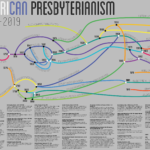Lessons from the RCA’s Vision 2020 Report
The Reformed Church in America (RCA) released its Vision 2020 Report this week, and some of its diagnoses are things to be taken into account for my own EPC. The report recommends that the RCA shift to affinity-based classes rather than being geography-based, allow each classis to determine their position on LGBT marriage and ordination, creating an independent missions board to maintain the RCA’s mission work if the denomination collapses, and mandating a gracious dismissal process for all RCA congregations. The recommendation on the missions board elicited a minority report from the committee that believes “Its structure is voluntary and pragmatic. By design, the agency would be extra-ecclesial, existing outside of the connection and accountability of a covenant community.” This criticism summarizes the warning lights that the RCA’s report contains.
This report and its recommendations are necessary because the RCA has been divided for decades on questions of what its unifying standards and structures should actually be…
Schism and Confessionalism
“And to stay in one’s own church despite much impurity in doctrine and life is our duty as long as it does not prevent us from being faithful to our own confession and does not force us, even indirectly, to…
On the Short History of Presbyterians and Clerical Collars
PCA pastor and visiting professor at Covenant Seminary Tim LeCroy has a great article dealing with the presbyterian origins of the clerical collar.
Here we see several members of the 18th c. Church of Scotland (Presbyterian) having their hackles raised over some ostentatious clergymen wearing scarlet cloaks and cravats. Later they hold a Synod where they decide that they ought to wear black gowns and to make use of neck bands. This paragraph shows us two things: the wearing of cravats was considered to be distinctive clerical garb, and the synod of the kirk decided ultimately that modest use of neckbands was permitted…

